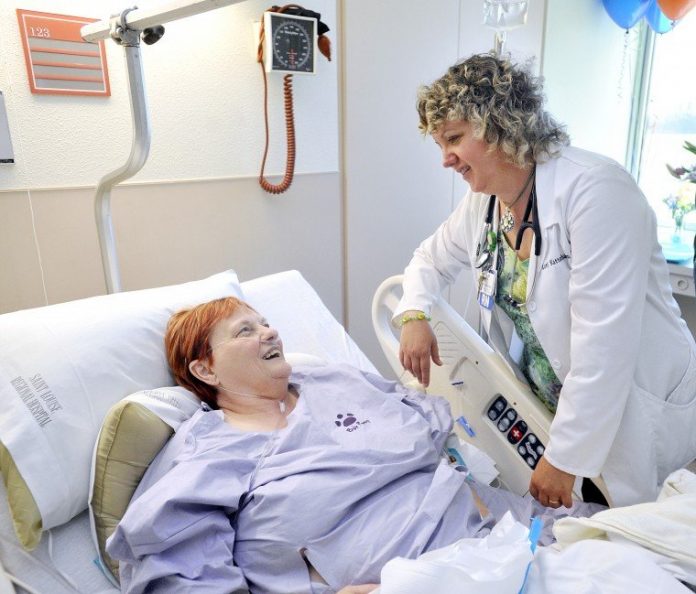
Saint Louise Regional Hospital and its owner the Daughters of Charity Health System are a key component of the local economy, so the hospital’s closure – in the event the DCHS can’t find a buyer – would have a significant impact on residents, according to South County officials.
DCHS announced last week that SLRH and five other hospitals it owns in California are up for sale, due to the organization’s struggling financial situation which includes an operating loss of more than $4 million at SLRH in 2012. The sale would also include Morgan Hill’s DePaul Medical Center, which is owned by DCHS.
SLRH employs more than 550 people, plus about 220 doctors, making it Gilroy’s third-largest employer, according to Gilroy Economic Development Corporation President and CEO Tammy Brownlow.
In Morgan Hill, only the Morgan Hill Unified School District employs more people than SLRH, according to City staff.
No potential buyers have been disclosed or expressed public interest in buying the health care system, though DCHS has been seeking a variety of buyers – Catholic, non-Catholic, for-profit and nonprofit – and is confident it will find one who intends to keep the properties open as hospitals and medical offices.
“For us, the right organization is (one) that both shares our vision to provide high quality, affordable health care to all members of the community,” DCHS spokeswoman Patricia Smith said. “We have a preference for those who share our Catholic Vincentian Values.”
Countywide, the combined operations of all hospitals create an annual economic impact of $14.3 billion, according to a report Brownlow recently submitted to the Gilroy Chamber, citing a panel discussion sponsored by the Silicon Valley Business Journal.
SLRH has a an estimated annual economic impact of more than $106 million, Brownlow’s report added.
SLRH Chief Administrative Officer Carol Furgurson is currently serving as the Gilroy EDC’s secretary/treasurer.
“From a service to South County standpoint, I think everybody is saddened to hear the Daughters of Charity have decided to sell the system, but it’s a totally understandable financial decision on their part,” Brownlow said.
If the DCHS can’t find a buyer, forcing bankruptcy and closure of SLRH, the impact would be “obviously huge,” however unlikely, she added.
“The economic impact of having the hospital here, and having excellent healthcare and emergency services for (local) residents is just critical,” said Brownlow.
A recent analysis of prospective buyers for DCHS’ Bay Area hospitals – conducted by the Silicon Valley Business Journal – listed a number of medical foundations and health care providers in California – including Santa Clara County – who might be interested in purchasing DCHS’ massive properties. However none of these competitors of DCHS have committed to doing so.
Gilroy’s General Plan cites the healthcare sector as “one that positively impacts Gilroy,” added Brownlow, who is serving on the City’s General Plan Update Committee.
Doctors at the 67,000-square-foot DePaul Medical Center in Morgan Hill are worried about any potential rezoning of the property, a likely request if the facility is purchased by a non-medical developer.
The property where the DePaul Medical Center is housed is zoned for “public facilities,” which allows uses such as hospitals and medical offices, according to Community Development Director Andrew Crabtree. If the owner of the property wanted to rezone the property, he or she would have to submit a General Plan amendment request, among other applications, to City Hall.
In the event of a property rezoning, doctors would have to move their practices, possibly to somewhere outside Morgan Hill and potentially depriving local residents of medical services.
“People like this building because it’s accessible, and parking is plentiful,” said pediatrician Mazhar Khan, who serves up to 125 patients per week at his office at the DePaul center. “We don’t know what the future holds (but) we want to stay in Morgan Hill and continue to serve the population.”
Formerly the site of SLRH, DePaul Medical Center was reopened in 2001 to accommodate private medical practices.
The City of Morgan Hill’s General Plan lists the opening of an acute-care hospital – similar to SLRH – in Morgan Hill as one of the City’s long-term goals, according to Crabtree. A suggested goal for the General Plan Update, which City staff and elected officials are in the process of crafting, is for residents to “have access to health care facilities as well as important community health amenities.”
Dermatologist Visoth Chhiap moved his offices into the DePaul center about eight years ago from San Jose. Doing so has made it easier on South County patients who “were so used to driving north” for treatment and doctor’s visits before dermatology was available in Morgan Hill.
If City officials allow a future owner to redevelop the DePaul property for residential, retail or industrial use, it will be next to impossible to replace the medical services at another site in town, said Chhiap, who employs three people at his office.
“There are excellent physicians here, and there’s no need to drive 45 minutes” for medical services, Chhiap said. “If the mayor and City Council were to be influenced to rezone, that would be a tremendous loss for our community. It’s about a vision of what a well-taken-care-of community has and I’d like to see that vision continue.”
Morgan Hill Mayor Steve Tate said the Council denied a rezoning request about 10 years ago for the DePaul property – which was largely vacant at the time – in order to keep medical services and their potential for expansion available on the site. So a rezoning away from the current medical use is unlikely, he noted.
“I would hope the Council would do everything they could to support our local doctors and those that continue to come here,” Tate said. “We want to support them because they support their community, and we have a lot of people who rely on them.”
Shedding more light on the details of why DCHS is forced to sell its hospitals, a flyer distributed to SLRH employees by hospital administrators notes that all DCHS hospitals have suffered financial losses in recent years, and those losses are not sustainable.
“Serving those most in need has been a tremendous blessing,” the flyer states. “However, hospitals like ours have faced a particularly daunting challenge to survive.”
Other reasons for the need to sell are the “rapid” changes in health care resulting from federal reform, cuts in reimbursements and an “uncertain global economy.” The flyer notes that no layoffs are expected, and no existing union contracts will be affected as long as DCHS is in control.
Chhiap noted that declining reimbursements from both private and public insurance providers, combined with the volume of uninsured patients served at SLRH’s emergency room over the years finally caught up to DCHS.
“You can only do so much charity work,” Chhiap said.
As a provider of indigent medical care, DCHS does not turn away patients because of inability to pay.
Doctors at DePaul Medical Center, like the general public, just found out about DCHS’ intent to sell its hospitals and medical facilities last week.
Just a few days before the announcement, Khan said DCHS representatives met with the doctors and notified them of a conceptual plan to sell the DePaul property and build a new facility for the doctors elsewhere in Morgan Hill. Then came the announcement, which hit the doctors “like a big bomb that fell on us,” said Khan.
Crabtree added that City staff have had “preliminary conversations” with DCHS about the impending sale. Others in the community want to keep the DePaul center as a medical facility, or even develop it as a full-fledged hospital.
“We want people in Morgan Hill to have access to a full range of medical facilities, including acute care hospitals,” Crabtree said. “There may be communities where the hospital is the major economic driver in that community, but that’s not traditionally the case in Morgan Hill. (But) it makes a positive contribution to the economy to have those kinds of uses.”














